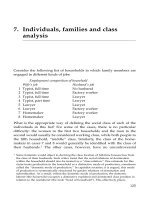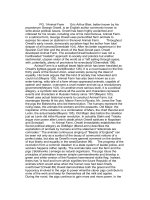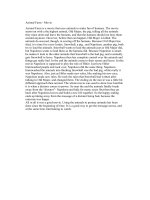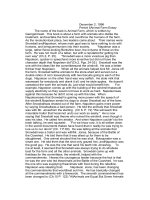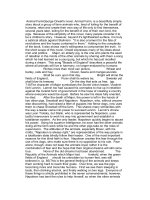animal families
Bạn đang xem bản rút gọn của tài liệu. Xem và tải ngay bản đầy đủ của tài liệu tại đây (4.03 MB, 66 trang )
A
A
A
A
A
A
A
A
A
families
Watch young animals learn to be grown-ups
A
s
s
e
e
n
o
n
ANIMAL
families
Dorling Kindersley
A Two Hands Production Ltd production
as seen on Channel Five
LONDON, NEW YORK,
MELBOURNE, MUNICH, and DELHI
Written and edited by Lorrie Mack
Project Designer Gemma Fletcher
Designers Mary Sandberg, Sonia Moore
Editors Penny Arlon, Alexander Cox, Penny Smith
Consultant Kim Dennis-Bryan PhD. FZS
Publishing Manager Bridget Giles
Managing Art Editor Rachael Foster
Category Publisher Mary Ling
Production Controller Claire Pearson
Production Editor Clare McLean
Jacket Editor Mariza OÕKeefe
First published in Great Britain in 2008 by
Dorling Kindersley Limited,
80 Strand, London, WC2R 0RL
Copyright © 2008 Dorling Kindersley Limited
A Penguin Company
AD406-05/08
All rights reserved. No part of this publication may be
reproduced, stored in a retrieval system, or transmitted
in any form or by any means, electronic, mechanical,
photocopying, recording, or otherwise, without the prior
written permission of the copyright owner.
A CIP catalogue record for this book
is available from the British Library
ISBN 978-1-40533-250-7
Colour reproduction by Alta Image, UK
Printed by Toppan, China
Discover more at
www.dk.com
I love hide-and-seek.
Mummy will never
Þnd me up here!
contents
Wait up! Walking
isnÕt easy with little
legs. I hope we stop
and rest soon.
Just like us
Animal families
Family facts
New babies
MumÕs milk
Brothers and sisters
Out for the day
Home sweet home
Rise and shine
Welcome to the world
Neat and tidy
Taking a dip
Meal time
Eat your greens
Gone Þshing
Carry me mum
4 Ð 5
6 Ð 7
8 Ð 9
10 Ð 11
12 Ð 13
14 Ð 15
16 Ð 17
18 Ð 19
20 Ð 21
22 Ð 23
24 Ð 25
26 Ð 27
28 Ð 29
30 Ð 31
32 Ð 33
34 Ð 35
Hide and seek
Mummy and me
Playtime
Climbing trees
Using tools
Sending signals
Watch me wobble
Follow my leader
Proud parents
I need a hug
Staying safe
Time for bed
The end
Glossary
Index
36 Ð 37
38 Ð 39
40 Ð 41
42 Ð 43
44 Ð 45
46 Ð 47
48 Ð 49
50 Ð 51
52 Ð 53
54 Ð 55
56 Ð 57
58 Ð 59
60 Ð 61
62 Ð 63
64
4
W
h
i
c
h
o
f
o
u
r
a
n
i
m
a
l
f
a
m
i
l
i
e
s
just like us
Do you live,
learn, eat, and play
with your family?
Animals do too!
We are animals, just like elephants,
monkeys, lions, bears, and hippos are
animals. Like your parents, many
animal parents take care of their
children and make sure theyÕre safe.
5
r
e
m
i
n
d
s
y
o
u
o
f
y
o
u
r
o
w
n
?
Learning new skills and tricks is an
important part of growing up.
Animal parents often cuddle their
babies too, and play with them, and
even make sure their faces and their
fur are neat. About the only thing
they donÕt do is nag about homework!
Your mum and dad make sure
you have the right foods to eat.
animal
families
Mums and dads together or
apart, one child or lots of
children, close friends or groups
of relations Ð theyÕre all families!
T
h
e
p
e
o
p
l
e
w
e
l
i
v
e
w
i
t
h
a
r
e
c
a
l
l
e
d
o
u
r
I live with my children
and their mum, and I
like to make sure they
all behave themselves!
rooster
Cattle live in big groups called
herds. Within one herd, many of
the calves might be related. They
all play, rest, and eat together.
6
hen
f
a
m
i
l
y
.
MoreÕs a crowd
Do you ever go out
with your friendsÕ
family? These
young hippos are
being looked after
by two mums.
There are lots
of different human
families too. Some have
one parent, some have
two, and some have
aunts, uncles,
and grandparents
as well.
HeÕs the boss
Giraffe herds are often led by one
or two strong males. All the females
and children follow them.
7
family facts
There are all sorts of animal
families with different ways
of life. Here are a few:
W
h
a
t
’
s
l
i
f
e
l
i
k
e
i
n
y
o
u
r
f
a
m
i
l
y
?
8
DadÕs turn
If you were a seahorse dad, you would carry
eggs in a safe pouch on your body until
theyÕre ready to hatch as baby seahorses.
Raccoon mums raise their children
alone. They leave them in the safest
place they can Þnd, like this cosy log.
Turn and turn about
Baby penguins are looked after
all the time. Their parents
leave to Þnd food as well, but
they take turns looking after
their little one.
9
Left alone
After a baby sea lion is born
(this one is
brand
new), his
mum takes care of him for
only a few days before she
needs to go off to Þnd food.
A male sea
lion is called
a bull. He has
lots of wives.
After mating,
he will go off
and live alone.
new babies
All worn out
This tired mother
lynx cuddles her new
baby close and
shuts her eyes.
cow and calf
A baby is about the most exciting
thing that can arrive in a family.
Newborns are very small and weak,
so their mums have to take extra-
special care of them.
Seven or eight baby
blue-tits usually hatch
at one time, so their
mum and dad have lots
of hungry new babies
to look after.
I hope he holds
on really tight!
macaques
12
mum’s milk
When theyÕre Þrst born, lots of baby
animals live on milk they get from their
mummy. Later, babies grow big enough
to eat grown-up food.
Puma cubs are born blind and
deaf, so itÕs a good thing they
donÕt have to look far for food.
orang-utans
People drink milk
from their mummy
too. Some babies keep
on doing this even
after theyÕve started
eating solid food.
M
o
t
h
e
r
s
’
m
i
l
k
i
s
b
e
s
t
Jacob sheep
13
Liquid lunch
Babies drink milk from their mumÕs
breasts. This hungry little sea cow
(sometimes called a
manatee
) can
even do it under water!
My brothers and sisters and
I are all VERY hungry.
Because mum sometimes
has three babies, she has
several breasts, or teats. I just
hope thereÕs enough milk!
grizzly bears
f
o
r
b
a
b
i
e
s
–
i
t
m
a
k
e
s
t
h
e
m
s
t
r
o
n
g
.
brothers
and sisters
How many brothers and sisters do
you have? Animals often have lots
and lots, and sometimes they are all
born at the same time!
G
e
t
t
i
n
g
i
n
t
o
m
i
s
c
h
i
e
f
i
s
s
o
m
u
c
h
14
These little piggies
live in a big family. Their mums usually
have up to ten babies, or even more.
Kittens love playing with
their family. Three to Þve
are normally born together.
m
o
r
e
f
u
n
w
h
e
n
t
h
e
r
e
’
s
a
g
a
n
g
o
f
u
s
.
Full load
How many of her babies can this
mother goosander Þt on her back?
15
Puppy love
Big dogs like labradors can
have up to 14 puppies at a
time. What a lot of puppies!
Sheep are a bit like people Ð
they tend to have just one
baby, or twins.
16
out for
the day
We can walk and swim as soon as
we hatch out of our eggs. We like
to waddle down to the pond with
our mum, but I canÕt always keep
up with the other ducks.
swan and cygnets
Mum likes
us all to go
exploring
together.
17
Sometimes my brother bumps into
me (he says itÕs an accident but
IÕm not sure). ItÕs OK, though Ð if
I trip over, someoneÕs always there
to make sure IÕm all right.
k
!
18
home sweet home
Houses keep humans safe and warm, and
many animals build shelters too. One
animal Ð the tortoise Ð even carries his
house around with him on
his back. ItÕs called a shell.
After bouncing
around, I like to go
to sleep in my cosy
underground tunnels,
called a warren.
tortoises
S
o
m
e
a
n
i
m
a
l
s
l
i
v
e
u
n
d
e
r
g
r
o
u
n
d
–
rabbit
19
Tree houses
Lots of birds build nests in
hollow trees to keep their
chicks safe. Using their beaks,
the birds make soft beds out of
twigs, leaves, moss, and
anything else they can Þnd.
Each night I make
myself a nest from
leaves and branches
high in the treetops.
I hope I donÕt fall out!
orang-utan
s
o
m
e
l
i
v
e
h
i
g
h
u
p
i
n
t
h
e
t
r
e
e
s
.
rise and shine
ItÕs hard to get moving in
the mornings when you feel
warm and sleepy. Sometimes
baby animals have trouble
waking up too.
20
Baby red foxes (called cubs) wake up
in the safety of a sheltered den.
zebra
21
Even for a wild rabbit, thereÕs
nothing like a good yawn
and a stretch to start the day.
Sniff sniff!
The morning air
smells funny.
These playful polar
bears are making
sure their mum
doesnÕt sleep in.
22
welcome to
the world
Animal mummies kiss and nuzzle their babies to
make sure they feel close and safe. This process,
which is called ÒbondingÓ, continues
all through childhood.
gorillas
cheetahs
If a new mum doesn’t bond with her
23
Safe smell
After two or three days, a baby
zebra (called a foal) knows its
mum by her smell, her voice,
and the way she looks. Until
then, mum wonÕt let any other
member of the herd near.
I get to know my
mum by rubbing her
furry face with my
nose and licking it
with my tongue.
Brrrrrr
This tiny seal has just been born on the
ice in Antarctica. Its mum will soon
leave to Þnd food. When she gets
back, sheÕll Þnd her baby by its smell.
baby, she may not take care of it.

